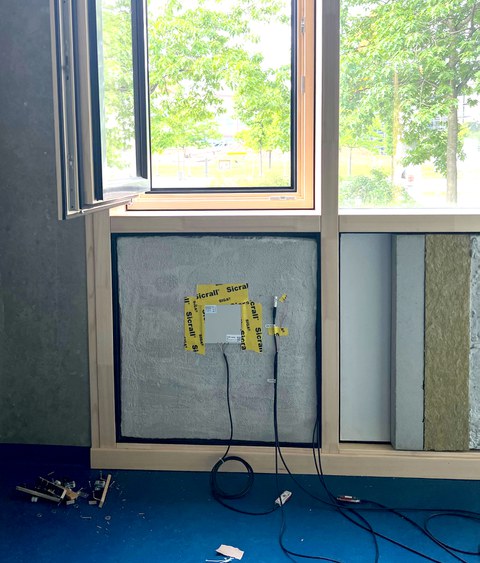Living Lab CUBE
Table of contents
Project data
|
Titel | Title |
Report in the annual report 2023
Reducing emissions

Heat flow plate and temperature sensor of Test Case 3
According to the recast Energy Performance of Buildings Directive (EPBD), it is crucial that new buildings reach a nearly zero-energy level after 2020, meaning that their energy demand is minimized and largely covered by renewable energy sources. This imperative is based on the realization that buildings in Europe are responsible for around 40 % of total energy consumption and 36 % of CO2 emissions. The EU targets for 2030 include a series of measures to reduce greenhouse gas emissions, promote renewable energy and increase energy efficiency. These targets require a profound market transformation in the construction sector to realize near-zero energy/emission and plus-energy buildings with high indoor air quality.
The selection of suitable materials and technical components to achieve Nearly Zero Emission Buildings (nZEBs) must consider various aspects, including environmental, technical, user experience, functional and design aspects. The utilization of products and resources through reuse, repair and recycling is crucial for the transition to a circular economy model. The development of materials and technical systems for ZEBs should aim to improve the thermal performance of buildings and ensure the quality of the indoor environment while reducing emission intensity.
In the project, 27 partners from 14 European countries are involved. Together, the Institute of Lightweight Structures and Polymer Technology and the Institute of Concrete Structures of TU Dresden research the sustainable implementation of carbon-reinforced concrete construction for nZEB. The development of carbon fiber reinforcement systems made from renewable raw materials and the integration of ultra-light aerated concrete in carbon-reinforced concrete structures are important focal points. The CUBE is used as a living lab in the local climate zone. Four different test elements (so called ‘Test Cases’) are installed in the installation slots provided in the CUBE and measured for an entire annual cycle. The recorded measurement data, including element and room temperature, relative humidity and heat flow, are transferred to the partners via a Nextcloud link. Test Case 3 with thermoelectric sensor (Seebeck effect), Test Case 4 with aerogel insulation + carbon-reinforced concrete and Test Case 6 with phase change material are currently being integrated in the CUBE.
